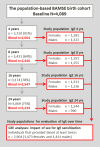Male sex is strongly associated with IgE-sensitization to airborne but not food allergens: results up to age 24 years from the BAMSE birth cohort
- PMID: 32489587
- PMCID: PMC7247167
- DOI: 10.1186/s13601-020-00319-w
Male sex is strongly associated with IgE-sensitization to airborne but not food allergens: results up to age 24 years from the BAMSE birth cohort
Abstract
Background: Up to half of the population in high-income countries has allergen-specific IgE antibodies. However, data regarding sex differences of IgE-sensitization from childhood to adulthood is limited.
Objective: To explore IgE-sensitization to common foods and airborne allergens in relation to sex over time in a population-based cohort followed up to young adulthood.
Methods: The Swedish population-based birth cohort BAMSE includes 4089 subjects who have been followed regularly with questionnaires and clinical investigations. A recent 24-year follow-up included 3069 participants (75%). Sera collected at 4, 8, 16 and 24 years were analyzed for IgE-antibodies to 14 common foods and airborne allergens.
Results: At 24 years sensitization to foods had decreased compared to previous follow-ups affecting 8.4%, while sensitization to airborne allergens was more common, affecting 42.2%. Male sex was associated with IgE-sensitization to airborne allergens at all ages (overall OR: 1.68, 95% CI 1.46-1.94) while there was no statistically significant association between sex and sensitization to food allergens (overall OR: 1.10, 95% CI 0.93-1.32). Levels of allergen-specific IgE did not differ significantly between males and females for any of the tested foods or airborne allergens at any age, following adjustment for multiple comparisons.
Conclusion: IgE-sensitization to airborne allergens increases with age up to young adulthood, whereas sensitization to food allergens seems to level off. Male sex is strongly associated with IgE-sensitization to airborne allergens from early childhood up to young adulthood. In contrast, there is little evidence for associations between sex and IgE-sensitization to foods.
Keywords: Allergen; BAMSE; Birth cohort; Immunoglobulin E; Prevalence; Sensitization.
© The Author(s) 2020.
Conflict of interest statement
Competing interestsEM has received lecture fees from Novartis, Sanofi and Thermo Fisher Scientific outside the submitted work. MvH has received lecture fees from Thermo Fisher Scientific and ALK; and consultancy fees from Biomay AG, Vienna, Austria and Hycor Biomedical LLC, CA, US, outside the submitted work. Dr. Westman reports personal fees from ALK (consultancy fees), outside the submitted work. The other authors report no competing interests relevant to this article.
Figures





References
-
- Pawankar R, Canonica GW, Holgate ST, Lockey RF, Organization WA . World Allergy Organization (WAO) White Book on Allergy. Milwaukee: WAO; 2011.
-
- Cox L, Williams B, Sicherer S, et al. Pearls and pitfalls of allergy diagnostic testing: report from the American College of Allergy, Asthma and Immunology/American Academy of Allergy, Asthma and Immunology Specific IgE Test Task Force. Ann Allergy Asthma Immunol. 2008;101:580–592. doi: 10.1016/S1081-1206(10)60220-7. - DOI - PubMed
LinkOut - more resources
Full Text Sources

